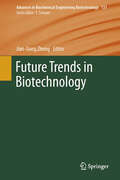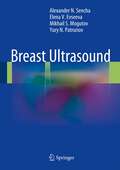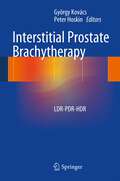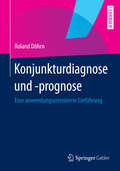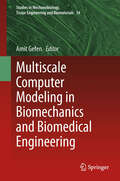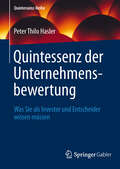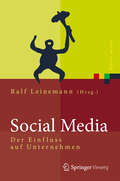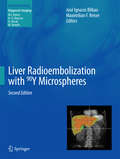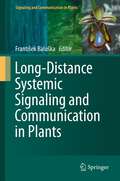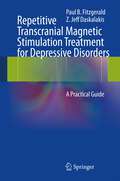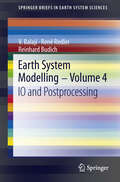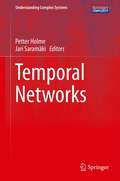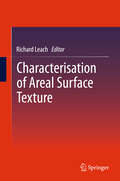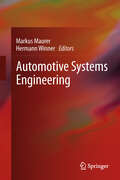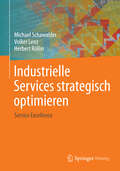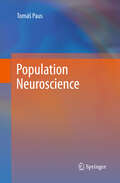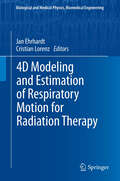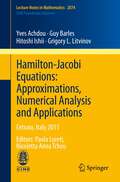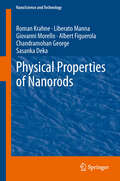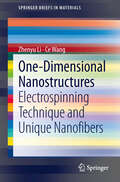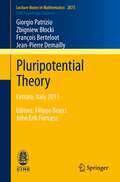- Table View
- List View
Future Trends in Biotechnology
by Jian-Jiang ZhongSystems Metabolic Engineering: The Creation of Microbial Cell Factories by Rational Metabolic Design and Evolution, by Chikara Furusawa, Takaaki Horinouchi, Takashi Hirasawa, Hiroshi Shimizu Impacts of Quorum Sensing on Microbial Metabolism and Human Health, by Yang-Chun Yong, Jian-Jiang Zhong CHO Glycosylation Mutants as Potential Host Cells to Produce Therapeutic Proteins with Enhanced Efficacy, by Peiqing Zhang, Kah Fai Chan, Ryan Haryadi, Muriel Bardor, Zhiwei Song Cell-Free Biosystems for Biomanufacturing, by Chun You, Y.-H. Percival Zhang Lipid Bilayer Membrane Arrays: Fabrication and Applications, by Xiaojun Han, Guodong Qi, Xingtao Xu, Lei Wang RNA Aptamers: A Review of Recent Trends and Applications, by Kyung-Nam Kang, Yoon-Sik Lee
Breast Ultrasound
by Alexander N. Sencha Yury N. Patrunov Mikhail S. Mogutov Elena V. EvseevaThis book is an ideal manual on the use of modern ultrasound in the diagnosis of breast pathology. It provides a comprehensive overview of current ultrasound techniques and explains the advantages and pitfalls of various ultrasound imaging modalities. Detailed attention is devoted to breast carcinoma, with guidance on differential diagnosis and presentation of pre- and postoperative ultrasound appearances. The most important benign breast diseases are also described and illustrated. Age-related features, including those seen in children and adolescents, are carefully analyzed, and an individual chapter is devoted to breast abnormalities in men. All aspects of lymph node appearances are reviewed in detail, with a special focus on the role of ultrasound in the evaluation of lymph node status. Ultrasound-guided breast interventions and imaging of breast implants are discussed in depth. This up-to-date and richly illustrated book will interest and assist specialists in ultrasound diagnostics, radiologists, oncologists, and surgeons.
Interstitial Prostate Brachytherapy
by Peter Hoskin György KovácsProstate brachytherapy has been the subject of heated debate among surgeons and the proponents of the various brachytherapy methods. This very first interdisciplinary book on the subject provides a comprehensive overview of innovations in low dose rate (LDR), high dose rate (HDR), and pulsed dose rate (PDR) interstitial brachytherapy for the management of local or locally advanced prostate cancer. In addition to detailed chapters on patient selection and the use of imaging in diagnostics, treatment guidance, and implantation control, background chapters are included on related medical physics issues such as treatment planning and quality assurance. The results obtained with the different treatment options and the difficult task of salvage treatment are fully discussed. All chapters have been written by internationally recognized experts who for more than a decade have formed the teaching staff responsible for the successful GEC-ESTRO/EAU Prostate Brachytherapy Teaching Course.
Konjunkturdiagnose und -prognose
by Roland DöhrnDas Buch stellt das breite Spektrum der in der Konjunkturanalyse gebräuchlichen Verfahren vor und dokumentiert deren Anwendung ein Beispielen aus der Praxis. Besonderes Augenmerk gilt dabei der Frage, wie die verschiedenen Verfahren zusammenwirken und zu einer praxistauglichen Prognose zusammengeführt werden können. Dabei wird auch auf die Datengrundlagen eingegangen und für die Konjunkturanalyse notwendige Schritte der Datenaufbereitung - z. B. die Saisonbereinigung - dargestellt. Auf eine formale Darstellung der angewendeten Methoden (z. B. Faktoranalyse, Diskriminanzanalyse, Regressionsanalyse) wird dabei weitgehend verzichtet, vielmehr soll der Leser die hinter den Verfahren stehenden Ideen verstehen. Der abschließende Teil des Buches befasst sich mit der Evaluation von Prognosen, also der Beurteilung von deren Treffsicherheit.
Cellular Aspects of Wood Formation (Plant Cell Monographs #20)
by Jörg FrommWith today's ever growing economic and ecological problems, wood as a raw material takes on increasing significance as the most important renewable source of energy and as industrial feedstock for numerous products. Its chemical and anatomical structure and the excellent properties that result allow wood to be processed into the most diverse products; from logs to furniture and veneers, and from wood chippings to wooden composites and paper. The aim of this book is to review advances in research on the cellular aspects of cambial growth and wood formation in trees over recent decades. The book is divided into two major parts. The first part covers the basic process of wood biosynthesis, focusing on five major steps that are involved in this process: cell division, cell expansion, secondary cell wall formation, programmed cell death and heartwood formation. The second part of the book deals with the regulation of wood formation by endogenous and exogenous factors. On the endogenous level the emphasis is placed on two aspects: control of wood formation by phytohormones and by molecular mechanisms. Apart from endogenous factors, various exogenous effects (such as climate factors) are involved in wood formation. Due to modern microscopic as well as molecular techniques, the understanding of wood formation has progressed significantly over the last decade. Emphasizing the cellular aspects, this book first gives an overview of the basic process of wood formation, before it focuses on factors involved in the regulation of this process.
Trends in Veterinary Sciences
by Alberto Gaiti Cristiano Boiti Antonio Pugliese Adriana FerlazzoVeterinary science is continuously achieving important developments in all its fields as a result of continuous technological advances in diagnostic tools and applied biology. This book contains 33 papers that were selected from those presented at the 65th Congress of the Italian Society for Veterinary Sciences held at Tropea-Drapia in 2011. It provides a timely overview of the current progress being made by Italian researchers and is of great value to anyone interested in all fields of veterinary science, both theoretical and applied, ranging from animal health and care to animal production and food hygiene.
Vertigo: A Clinical Guide
by Shabih H. Zaidi Arun SinhaThis monograph on vertigo is based on the personal, hands-on, practical and clinical experience of managing vertigo in a large university-affiliated hospital. It covers all aspects of the subject, offering the latest information on epidemiology, aetiopathogenesis, diagnostics, the battery of vestibular and allied tests, treatment, rehabilitative management and ethical considerations. The neglected but substantial problem of paediatric vertigo is addressed, as are the many pathologies in the elderly population that can lead to disequilibrium and repeated falls. This book will prove of value to a range of practitioners, including family physicians, otologists, audiologists, vestibular scientists, neurologists, paediatricians, geriatricians, physiotherapists, rehabilitation therapists and general doctors, as well as medical and nursing students.
Multiscale Computer Modeling in Biomechanics and Biomedical Engineering
by Amit GefenThis book reviews the state-of-the-art in multiscale computer modeling, in terms of both accomplishments and challenges. The information in the book is particularly useful for biomedical engineers, medical physicists and researchers in systems biology, mathematical biology, micro-biomechanics and biomaterials who are interested in how to bridge between traditional biomedical engineering work at the organ and tissue scales, and the newer arenas of cellular and molecular bioengineering.
Quintessenz der Unternehmensbewertung: Was Sie als Investor und Entscheider wissen müssen
by Peter Thilo HaslerFür einen ambitionierten Investor gibt es an den Börsen viele Fallstricke. Um einen dauerhaften Anlageerfolg zu gewährleisten, kommt es deshalb in der Praxis insbesondere auf die Fähigkeit an, Unternehmen systematisch zu bewerten. Dieses Buch liefert umfassende und nachvollziehbare Erläuterungen aller relevanten Bewertungsverfahren: vom Dividendendiskontierungsmodell über Wertschöpfungs- und DCF-Modelle bis hin zu den gängigen Methoden der vergleichenden, marktorientierten Multiplikatorbewertung. Anhand von konkreten Bewertungsfällen kann der Leser dabei sein neu erworbenes Wissen unmittelbar und anschaulich anwenden. Die "Quintessenz der Unternehmensbewertung" richtet sich an professionelle Kapitalmarktteilnehmer, an Manager, Aufsichtsräte und Miteigentümer von Unternehmen ebenso wie an ambitionierte Privatanleger, die ihre Kenntnisse vertiefen wollen.
Social Media
by Ralf LeinemannDie Beiträge aus unterschiedlichen Unternehmen bieten eine fundierte Darstellung zum Einfluss sozialer Medien (Facebook, Twitter, LinkedIn, Xing, etc) auf die Kommunikation und Aussendarstellung von Unternehmen sowie auf interne Prozesse. Die Autoren erläutern zunächst den Einfluss auf interne und externe Kommunikation, die Kommunikationsqualität in sozialen Medien und die Chancen und Risiken der neuen Medien. Die Einflüsse auf die verschiedenen Unternehmensbereiche werden aus der Praxis heraus diskutiert. Zu den adressierten Bereichen gehören die Auswirkungen auf PR und Analyst Relations sowie auf Kommunikation und IT-Infrastruktur. In zwei abschließenden Kapiteln werden auch einzelne Branchen beleuchtet und ein internationaler Vergleich vorgestellt.
Liver Radioembolization with 90Y Microspheres
by José Ignacio Bilbao Maximilian F. ReiserThis is the second edition of a very well received book devoted specifically to the treatment of liver tumors by radioembolization with 90Y microspheres. The success of the first edition was based on the provision of all the fundamental information required for successful use of this therapeutic modality in clinical practice. The new edition has been fully updated to cover the most recent advances and includes additional chapters on regulations and emerging trends. Detailed information is provided on the full range of relevant topics, including hepatic vascular anatomy (including variants), dosimetry, assessment of tumor response, and the results achieved using radioembolization alone and in combination with other treatments in patients with primary or metastatic disease. Complications and side-effects are also fully discussed. This book will prove immensely valuable for both beginners and practitioners.
Long-Distance Systemic Signaling and Communication in Plants
by František BaluškaOur view of plants is changing dramatically. Rather than being only slowly responding organisms, their signaling is often very fast and signals, both of endogenous and exogenous origin, spread throughout plant bodies rapidly. Higher plants coordinate and integrate their tissues and organs via sophisticated sensory systems, which sensitively screen both internal and external factors, feeding them information through both chemical and electrical systemic long-distance communication channels. This revolution in our understanding of higher plants started some twenty years ago with the discovery of systemin and rapid advances continue to be made. This volume captures the current 'state of the art' of this exciting topic in plant sciences.
Repetitive Transcranial Magnetic Stimulation Treatment for Depressive Disorders
by Paul B Fitzgerald Z. Jeff DaskalakisRepetitive transcranial magnetic stimulation (rTMS) treatment is increasingly being used in the management of patients with depression. Nevertheless, considerable ignorance still exists about the treatment in general psychiatric practice. This concise clinical guide will serve as a reference and practical tool for clinicians working with or learning about this treatment technique. The opening chapters provide basic information on the history and development of rTMS treatment and its mechanism of action. Use of the treatment in depression is then addressed in detail, with explanation of the evidence base and discussion of a variety of clinical issues. Side-effects of treatment are explored, and careful consideration is given to the establishment of rTMS treatment programs and the training of clinicians. The final chapters will provide a brief overview of potential rTMS applications in other psychiatric conditions and some background on related treatments.
Earth System Modelling - Volume 4
by Reinhard Budich René Redler V. BalajiCollected articles in this series are dedicated to the development and use of software for earth system modelling and aims at bridging the gap between IT solutions and climate science. The particular topic covered in this volume addresses the issue of data input/output and post-processing in the context of Earth system modeling, with an emphasis on parallel I/O, storage management and analysis subsystems for very large scale data requirements.
Temporal Networks
by Jari Saramäki Petter HolmeThe concept of temporal networks is an extension of complex networks as a modeling framework to include information on when interactions between nodes happen. Many studies of the last decade examine how the static network structure affect dynamic systems on the network. In this traditional approach the temporal aspects are pre-encoded in the dynamic system model. Temporal-network methods, on the other hand, lift the temporal information from the level of system dynamics to the mathematical representation of the contact network itself. This framework becomes particularly useful for cases where there is a lot of structure and heterogeneity both in the timings of interaction events and the network topology. The advantage compared to common static network approaches is the ability to design more accurate models in order to explain and predict large-scale dynamic phenomena (such as, e.g., epidemic outbreaks and other spreading phenomena). On the other hand, temporal network methods are mathematically and conceptually more challenging. This book is intended as a first introduction and state-of-the art overview of this rapidly emerging field.
Characterisation of Areal Surface Texture
by Richard LeachThe function of a component part can be profoundly affected by its surface topography. There are many examples in nature of surfaces that have a well-controlled topography to affect their function. Examples include the hydrophobic effect of the lotus leaf, the reduction of fluid drag due to the riblet structure of shark skin, the directional adhesion of the gecko foot and the angular sensitivity of the multi-faceted fly eye. Surface structuring is also being used extensively in modern manufacturing. In this way many properties can be altered, for example optical, tribological, biological and fluidic. Previously, single line (profile) measurements were adequate to control manufacture of surfaces, but as the need to control the functionality of surfaces increases, there is a growing need for three-dimensional (areal) measurement and characterisation techniques. For this reason there has been considerable research, development and standardisation of areal techniques. This book will present the areal framework that is being adopted by the international community. Whereas previous books have concentrated on the measurement aspects, this book concentrates on the characterisation techniques, i.e. how to interpret the measurement data to give the appropriate (functional) information for a given task. The first part of the book presents the characterisation methods and the second part case studies that highlight the use of areal methods in a broad range of subject areas - from automobile manufacture to archaeology. Contents Introduction to Surface Topography The Areal Field Parameters The Areal Feature Parameters Areal Filtering Methods Areal Form Removal Areal Fractal Methods Choosing the Appropriate Parameter Characterisation of Individual Areal Features Multi-Scale Signature of Surface Topography Correlation of Areal Surface Texture Parameters to Solar Cell EfficiencyCharacterisation of Cylinder Liner Honing Textures for Production Control Characterisation of the Mechanical Bond Strength for Copper on Glass Plating Applications Inspection of Laser Structured Cams and Conrods Road Surfaces
Automotive Systems Engineering
by Hermann Winner Markus MaurerThis book reflects the shift in design paradigm in automobile industry. It presents future innovations, often referred as "automotive systems engineering". These cause fundamental innovations in the field of driver assistance systems and electro-mobility as well as fundamental changes in the architecture of the vehicles. New driving functionalities can only be realized if the software programs of multiple electronic control units work together correctly. This volume presents the new and innovative methods which are mandatory to master the complexity of the vehicle of the future.
Industrielle Services strategisch optimieren: Service Excellence
by Michael Schawalder Herbert Röllin Volker LenzDieses Buch beschreibt einen neu entwickelten ganzheitlichen Lösungsansatz für das Servicegeschäft in der Industrie, kombiniert mit dem Customer Relationship Management, kurz CRM. Anhand des neu entwickelten Ganzheitlichen Service Geschäftsmodells (GSG-Modell) wird dem Leser ein Weg aufgezeigt, wie das Servicegeschäft von Industrieunternehmen auf einen neuen Level gebracht wird - hin zum Service Excellence. Das Buch erklärt den Weg von den bisher meist transaktionalen Kundenbeziehungen hin zum professionellen Beziehungsmanagement und integriert das CRM ins Servicegeschäft. Aus den theoretischen Themenbereichen CRM und den Leistungssystemen wurde das praxisorientierte GSG-Modell entwickelt. Abschließend wird anhand von 5 Schritten die Umsetzung des Modells hin zum Service Excellence beschrieben.
Population Neuroscience
by Tomas PausIs Newton's brain different from Rembrandt's? Does a mother's diet during pregnancy impact brain growth? Do adolescent peers leave a signature in the social brain? Does the way we live in our middle years affect how our brains age? To answer these and many other questions, we can now turn to population neuroscience. Population neuroscience endeavors to identify environmental and genetic factors that shape the function and structure of the human brain; it uses the tools and knowledge of genetics (and the "omics" sciences), epidemiology and neuroscience. This text attempts to provide a bridge spanning these three disciplines so that their practitioners can communicate easily with each other when working together on large-scale imaging studies of the developing, mature and aging brain. By understanding the processes driving variations in brain function and structure across individuals, we will also be able to predict an individual's risk of (or resilience against) developing a brain disorder. In the long term, the hope is that population neuroscience will lay the foundation for personalized preventive medicine and, in turn, reduce the burden associated with complex, chronic disorders of brain and body.
Balances: Instruments, Manufacturers, History
by Erich Robens Shanath Amarasiri A. Jayaweera Susanne KieferThe book deals mainly with direct mass determination by means of a conventional balances. It covers the history of the balance from the beginnings in Egypt earlier than 3000 BC to recent developments. All balance types are described with emphasis on scientific balances. Methods of indirect mass determination, which are applied to very light objects like molecules and the basic particles of matter and celestial bodies, are included As additional guidance, today's manufacturers are listed and the profile of important companies is reviewed. Several hundred photographs, reproductions and drawings show instruments and their uses. This book includes commercial weighing instruments for merchandise and raw materials in workshops as well as symbolic weighing in the ancient Egyptian's ceremony of 'Weighing of the Heart', the Greek fate balance, the Roman Justitia, Juno Moneta and Middle Ages scenes of the Last Judgement with Jesus or St. Michael and of modern balances. The photographs are selected from the slide-archives of the late Richard Vieweg (1896-1972) (former President of the Physikalisch-Technische Bundesanstalt, Braunschweig, Germany), of the late Hans R. Jenemann (1920-1966) (former head of the Analytical Laboratory of Schott & Gen. , Mainz, Germany) and of his wife Irene (1933-2008) and of Erich Robens.
4D Modeling and Estimation of Respiratory Motion for Radiation Therapy (Biological and Medical Physics, Biomedical Engineering)
by Cristian Lorenz Jan EhrhardtRespiratory motion causes an important uncertainty in radiotherapy planning of the thorax and upper abdomen. The main objective of radiation therapy is to eradicate or shrink tumor cells without damaging the surrounding tissue by delivering a high radiation dose to the tumor region and a dose as low as possible to healthy organ tissues. Meeting this demand remains a challenge especially in case of lung tumors due to breathing-induced tumor and organ motion where motion amplitudes can measure up to several centimeters. Therefore, modeling of respiratory motion has become increasingly important in radiation therapy. With 4D imaging techniques spatiotemporal image sequences can be acquired to investigate dynamic processes in the patient's body. Furthermore, image registration enables the estimation of the breathing-induced motion and the description of the temporal change in position and shape of the structures of interest by establishing the correspondence between images acquired at different phases of the breathing cycle. In radiation therapy these motion estimations are used to define accurate treatment margins, e.g. to calculate dose distributions and to develop prediction models for gated or robotic radiotherapy. In this book, the increasing role of image registration and motion estimation algorithms for the interpretation of complex 4D medical image sequences is illustrated. Different 4D CT image acquisition techniques and conceptually different motion estimation algorithms are presented. The clinical relevance is demonstrated by means of example applications which are related to the radiation therapy of thoracic and abdominal tumors. The state of the art and perspectives are shown by an insight into the current field of research. The book is addressed to biomedical engineers, medical physicists, researchers and physicians working in the fields of medical image analysis, radiology and radiation therapy.
Hamilton-Jacobi Equations: Paola Loreti, Nicoletta Anna Tchou
by Yves Achdou Paola Loreti Nicoletta Tchou Guy Barles Grigory L. Litvinov Hitoshi IshiiThese Lecture Notes contain the material relative to the courses given at the CIME summer school held in Cetraro, Italy from August 29 to September 3, 2011. The topic was "Hamilton-Jacobi Equations: Approximations, Numerical Analysis and Applications". The courses dealt mostly with the following subjects: first order and second order Hamilton-Jacobi-Bellman equations, properties of viscosity solutions, asymptotic behaviors, mean field games, approximation and numerical methods, idempotent analysis. The content of the courses ranged from an introduction to viscosity solutions to quite advanced topics, at the cutting edge of research in the field. We believe that they opened perspectives on new and delicate issues. These lecture notes contain four contributions by Yves Achdou (Finite Difference Methods for Mean Field Games), Guy Barles (An Introduction to the Theory of Viscosity Solutions for First-order Hamilton-Jacobi Equations and Applications), Hitoshi Ishii (A Short Introduction to Viscosity Solutions and the Large Time Behavior of Solutions of Hamilton-Jacobi Equations) and Grigory Litvinov (Idempotent/Tropical Analysis, the Hamilton-Jacobi and Bellman Equations).
Physical Properties of Nanorods
by Albert Figuerola Chandramohan George Giovanni Morello Liberato Manna Roman Krahne Sasanka DekaInorganic nanoparticles are among the most investigated objects nowadays, both in fundamental science and in various technical applications. In this book the physical properties of nanowires formed by nanoparticles with elongated shape, i.e. rod-like or wire-like, are described. The transition in the physical properties is analyzed for nanorods and nanowires consisting of spherical and rod-like nanoparticles. The physical properties of nanowires and elongated inorganic nanoparticles are reviewed too. The optical, electrical, magnetic, mechanical and catalytic properties of nanowires consisting of semiconductors, noble and various other metals, metal oxides properties and metal alloys are presented. The applications of nanorods and nanowires are discussed in the book.
One-Dimensional nanostructures
by Ce Wang Zhenyu LiOne-Dimensional Nanostructures: Electrospinning Technique and Unique Nanofibers is a comprehensive book depicting the electrospinning technique and related 1D unique electrospun nanofibers. The first part of the book focuses on electrospinning technique, with chapters describing Electrospinning setup, electrospinning theories, and related working parameter. The second part of the book describes in detail specific topics on how to control the electrospun fiber properties such as how to control the fiber direction, how to control the fiber surface morphology, how to control the fiber structure, and how to construct 3D structures by electrospun fibers. The final part of the book depicts the applications of the electrospun nanofibers, with sections describing in detail specific fields such as electrospun nanofiber reinforcement, filtration, electronic devices, lithium-ion batteries, fuel cells, biomedical field, and so on. One-Dimensional Nanostructures: Electrospinning Technique and Unique Nanofibers is designed to bring state-of-the-art on electrospinning together into a single book and will be valuable resource for scientists in the electrospinning field and other scientists involved in biomedical field, mechanical field, materials, and energy field. Dr. Zhenyu Li is an associate professor at the Dept. of Chemistry, Jilin University, Changchun, P. R. China. Currently, he also holds the position in Australian Future Fibres Research & Innovation Centre, Institute for Frontier Materials, Deakin University, Geelong, Victoria, Australia. Dr. Ce Wang is a professor at the Dept. of Chemistry, Jilin University, Changchun, P. R. China.
Pluripotential Theory: Filippo Bracci, John Erik Fornæss
by John Erik Fornæss Francois Berteloot Jean Pierre Demailly Filippo Bracci Giorgio Patrizio Zbigniew BłockiPluripotential theory is a very powerful tool in geometry, complex analysis and dynamics. This volume brings together the lectures held at the 2011 CIME session on "pluripotential theory" in Cetraro, Italy. This CIME course focused on complex Monge-Ampére equations, applications of pluripotential theory to Kahler geometry and algebraic geometry and to holomorphic dynamics. The contributions provide an extensive description of the theory and its very recent developments, starting from basic introductory materials and concluding with open questions in current research.
